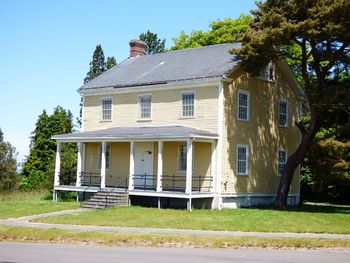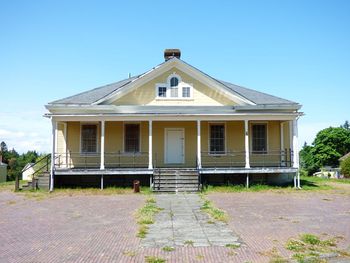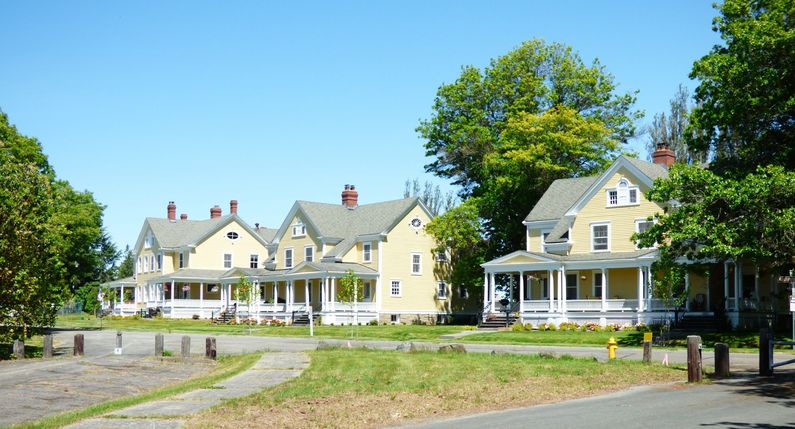Fort Lawton
| More information at Warlike, Wikidata, Wikipedia
Fort Lawton (1900-1970) - Initially established on 9 Feb 1900 to protect Puget Sound from naval attack. The fort was named in G.O. 20, 19 Feb 1900, after Major General Henry Ware Lawton (1843-1899), U.S. Volunteers (Colonel and inspector general, U.S. Army), who was killed in action at San Mateo, Philippines Islands on 19 Dec 1899. He was a veteran of the U.S. Civil War and of the Indian Wars. Fort Lawton was abandoned by the U.S. Army in 2012.
Endicott Period (1890-1910)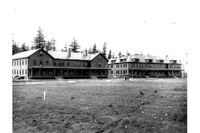 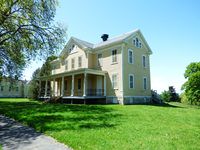 In 1896, the Secretary of War selected what would later be Fort Lawton for the construction of an artillery battery intended to defend Seattle and the south Puget Sound from naval attack. Local citizens and governments and the Seattle Chamber of Commerce launched a canvass of donations of land and cash and in February 1898, turned over to the U.S. Army title to 703 acres of land for the installation. Construction of buildings and roads began in June 1898. The first soldiers arrived in December 1899. The fort opened on 9 Feb 1900 on a 1,100-acre site, which was redesigned in 1902 for infantry use. Originally planned as a coastal fortification, the first Coast Artillery unit did not arrive at Fort Lawton until July 1901, and guns were installed only temporarily. Fort Worden and Fort Flagler near Port Townsend on the Olympic Peninsula and Fort Casey (1) on Whidbey Island were built for heavy guns as the first and second lines of defense, and Fort Lawton would be the third line of defense. In May 1902, the Fort became an Infantry post and although it was designed to accommodate a full regiment (approximately 3,500 men), it rarely saw more than a headquarters and one battalion. In 1910 a design overhaul, to include housing for officers and enlisted men was prepared by landscape architect John C. Olmsted. In 1927, the fort was converted into a Corps of Engineers installation. In 1938, the Army offered to sell Fort Lawton back to the city of Seattle for one dollar, but the city declined, citing maintenance concerns.
World War II (1941-1945)During World War II, Fort Lawton became part of the Port of Embarkation, San Francisco. At least 20,000 troops were stationed at Fort Lawton at a time during the war and the post expanded to some 450 temporary buildings. A total of 1.1 million troops passed through the installation during and after the war. The post was also used as a Prisoner of War (POW) camp, with more than 1,000 Germans imprisoned there and approximately 5,000 Italians passing through en route to Hawaii for imprisonment. On 15 Aug 1944 an Italian POW, Guglielmo Olivotto, was found murdered at Fort Lawton after a night of rioting between Italian POWs and American soldiers. Twenty-eight African-American soldiers were later court-martialed, convicted of the crime, and sent to prison. Future Watergate scandal Special Prosecutor Leon Jaworski was the prosecutor.
Cold War (1947-1991)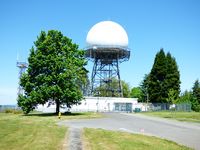 After World War II, Fort Lawton housed the Fort Lawton Air Force Station and the associated 635th AC&W Squadron as well as a surface-to-air Nike missile site, (Fort Lawton Army Air Defense Command Post S-90DC), a training center and it currently houses the Fort Lawton FAA Radar Site. The Korean War brought a flurry of activity as troops headed to or returned from Korea processed through Fort Lawton. On Memorial Day 1951, a Freedom Grove of trees and monuments honoring war dead was dedicated near the post chapel. In February 1953, the Fort Lawton Processing Center transferred half of its functions, the outbound tasks, to Fort Lewis (now called Joint Base Lewis McChord). Returnees continued to process through Fort Lawton. In the late 1950s, Nike anti-aircraft missiles and radar were in use at Fort Lawton, but in 1968 the site was rejected for proposed defense upgrades. The Army Surplus 534 acres in 1971, which was given back to the city in 1972, and dedicated as Discovery Park in 1973. The convictions of the 1944 rioters were set aside in 2007. A formal army apology ceremony was held on 26 Jul 2008 to present to the relatives of former soldiers and the two remaining survivors years of back pay following the overturn of their dishonorable discharges.
Current Status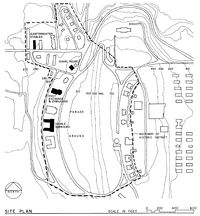 Starting in 1972 parcels of Fort Lawton were returned to Seattle to become the present-day Discovery Park. A U.S. Army Reserve compound including Leisy Hall remained on West Texas Way until the 364th Expeditionary Sustainment Command left Fort Lawton on 25 Feb 2012 for Marysville, Washington. It is unclear if the city has fully acquired the reserve compound property. The remaining twenty-five main post buildings were included in the National Register of Historic Places in a Historic District within the bounds of Discovery Park. Three main areas were included in the designation, the historic officer and NCO quarters, the lower post enlisted quarters and support buildings, and the stables area. The housing areas are now privately owned and occupied. The other historic buildings have either been destroyed or are boarded up and deteriorating. A Cleveland-based real estate management and development company now owns the 26 remaining officer and NCO quarters and is in the process of selling them as a package. The 26 housing units are in 14 Colonial Revival buildings built in 1904 and 1905. They consist of 2 single-family houses and 12 duplexes. The three enlisted barracks that existed when the historic area was declared are gone and only the band barracks remain. The band barracks, the post exchange, the guardhouse, a civilian quarters building, and two stable buildings are boarded up and un-interpreted. The only interpretive sign for the fort is located near the flagpole. Discovery Park has a visitor center inside the east entrance to the park and three parking lots within the park. A free B&W map of the park is available at the visitor center but there is no brochure describing the buildings or detailing the history of the post.
See Also:
Sources:
Links:
Publications:
Fortification ID:
Visited: 20 May 2014 Picture Gallery
| |||||||||||||||||||||||||||||||||||||||||||
